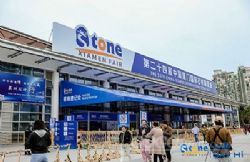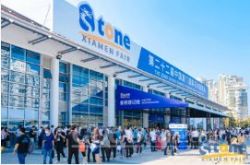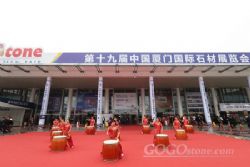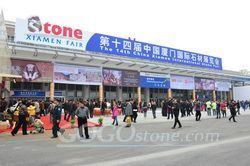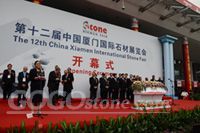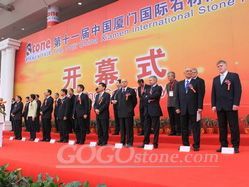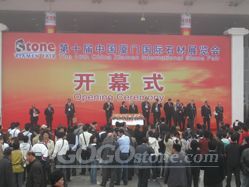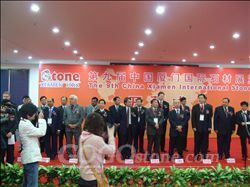Location : Home > News > News
Stone Summit:There’s something about quartzite
( Date: 2021/5/4 10:32:31 )
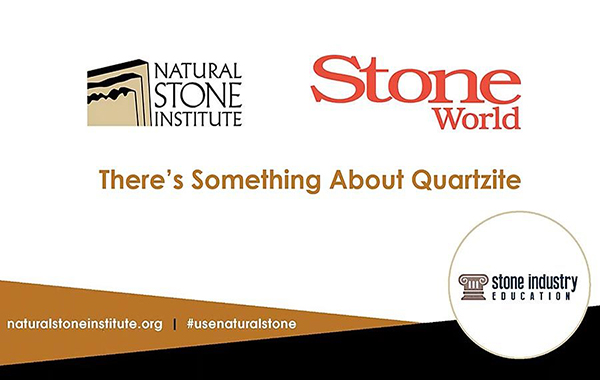
The Natural Stone Institute, in partnership with Stone World, held one of its regularly scheduled virtual Stone Summits on April 14, 2021. The topic of quartzite proved to be a “hot” issue among fabricators, as it drew record-breaking numbers of attendees. During the hour-and-a-half-long session, the discussion touched on a variety of points – from the composition of quartzite to the challenges working with the material to the proper tooling to use in the production process.
Moderated by Mark Meriaux, accreditation and technical manager of the Natural Stone Institute, a panel was composed of industry experts to speak to the audience and address issues and concerns relating to quartzite. The panel included:
Craig Griffin, GMR Quality Stone Products
Andrew Landis, InnoChem/Akemi
Ed Mink, Product Manager, GranQuartz
Klint Olsen, West Coast region, GranQuartz
Learning objectives were outlined at the start of the presentation. They included:
Review the geology of quartzite.
Discuss the strengths of quartzite as a building material and how best to use this material in applications.
Learn how to set expectations with customers when selling quartzite.
Create a plan to maximize the value of this material to both your company and customer.
“We’ll talk about some of the issues that our panelists have run into with quartzite and their customers in the past few years,” said Meriaux. “There is no 100% solution to solve every issue with quartzite. We do have some best practices to share with you today that we hope will lessen, and maybe sometime soon eliminate, these issues.”
Meriaux explained that because quartzite is made of the mineral quartz it is very hard and abrasion resistant. “Quartz as a mineral is very chemical resistant,” he said. “The test for a true quartzite is an acid test.”
Why is quartzite so desirable? Meriaux noted several reasons:
It is hard and scratch resistant.
It has strong resistance to acids.
Cross bedding pattern has a marble-like look.
Light colors (gray and light earth tones).
Issues with resin
“One of the big issues that we hear about a lot is that most stones -- not just quartzites -- go through a resin process before they are shipped to the U.S.,” said Meriaux. “There are three main reasons resin is applied to stone. 1. To fill small pits and fissures – improve the overall surface finish. 2. To help bind /strengthen the surface of the material. 3. To add some stain protection – reduce absorption.”
“It is our experience that resin is actually trapping moisture,” said Landis. “It keeps moisture from coming out, so it is blocking it both ways.”
“I think it is one of those double edge swords,” said Griffin. “It’s needed in the industry to draw attraction to these different types of stones that are coming from overseas, but it is also causing problems that fabricators and even restoration guys are dealing with on a daily basis.”
Landis talked about tests Akemi ran on samples of quartzite, and how it showed that the slabs without resin didn’t have staining or water absorption like the ones that did have resin on them. “I first brought the subject to Akemi in early 2020,” he said. “We were concentrating on absorption.” Landis explained that Akemi said they could obtain the samples where they are based in Europe. “They polished a processed edge and then put it in a water bath filled with oils and soaps commonly seen in household,” he said. “[The samples] laid in there to see if they were getting water absorption. This went on for some weeks, and they didn’t see any problems. [The stone] dried very quickly. It turned out they weren’t resin treated. They then did samples with resin and started to see the edges bleed. Water on the edges would not evaporate quickly. They could get the moisture out with a torch and heat very fast, but any staining from the water remained. That is the challenge. How do we keep the moisture from going in and how do we remove it?”
Acid treatments
According to Meriaux, quartzite slabs in countries such as Brazil are going through acid baths or acid treatments. Not all quartzites, but usually the lighter colored ones.
“I believe the acid treatments are designed to get rid of the iron that can be in the stone,” said Griffin. “They actually dip the slabs into a bath of acid for a day or a few days. What will happen is that acid will penetrate all the way through the slab. As they pull the slab out they will soak it in a neutralizer cleaner – a high alkaline cleaner. The problem is that during these baths the chemicals have surfactants in it. Surfactants are chemicals that are found in dish detergent and hand soap and are designed to attract grease, grime and dirt.”
Griffin went on to say that if a slab coming out of the bath isn’t fully rinsed or cleaned, the surfactants can attach themselves within the stone and when any moisture seeps into the stone the surfactants will attach themselves to the grease and grime. “It is extremely difficult to pull the chemicals out or oil or what have you,” he said. “If a stone is not wiped down, it can pull them in. Most stains are occurring on the edges, whether from moisture or grease. We can get it a lot lighter, but we will still have a residue of what seeped in to that stone.”
Meriaux addressed the reasons why stone producers would put quartzite slabs in these baths if it can cause problems such as trapped moisture and staining. “It is obviously to lighten the stone and eliminate some of the iron-based minerals that can cause staining,” he said. “It’s to create a more desirable product for the consumers, designers and you who are selling the material. You have asked for it so the quarriers and the factories are doing everything they can to give you the best product you are asking for. But it is certainly something contributing to the issues we are seeing.”
Diamond technology
A common question among fabricators is “How do you cut quartzite?” Meriaux deferred to Olsen and Mink from GranQuartz to weigh in. “Diamond technology is specific to quartzite material,” said Olsen. “We do not use the same diamonds that we would use is in a marble or granite blade. I’ll let Ed speak more specific on this.”
Mink explained that quartzite diamond products have a softer bond compared to your typical brand engineered saw blades. “The biggest problem I see is guys trying to cut Taj Mahal at 20 feet like they cut engineered stone with a granite blade,” he said. “One thing is it will glaze over or you crash a blade and lose segments. You have to take time to switch the blade and use one that is made for quartzite. It will cut faster. The bond is softer and wears down faster than other diamond blades.”
Speaking for the audience, Meriaux asked what would happen if a fabricator used a regular granite blade to cut quartzite? “It will cut, but you will be cutting slower and dressing more often,” explained Mink.
Mink explained that a fabricator can use a quartzite blade on granite or engineered stone, but they will go through significantly more blades. He recommends using a specific type of blade for each material.
The virtual Stone Summit went on to discuss several more issues pertaining to quartzite, as well as sharing some case stories. With this being such an important subject for fabricators, Stone World plans to cover different topics regarding the material in the coming months. Be sure to watch out for these stories.
The next virtual Stone Summit will be held on June 9 to 10, 2021. It will focus on “Theories in Templating.” Visit www.stoneindustryeducation.com for more information.
From: stoneworld
Latest Resources
- Pacific Shore Stones Celebrates Two Deca...
- Domestic ceramic tile manufacturers seek...
- Kerakoll to open new production facility...
- Stone, carbon fibres and biochar cited a...
- World Floor Covering Association Introdu...
- Ceramics of Italy Previews Coverings 202...
- Coverings 2024 Earth Day Activations wil...
- Lunada Bay Tile refreshes Linen collecti...
- Design Holding Opens Flagship Store
- ISFA Revamps Regional Events
Previous Fair

